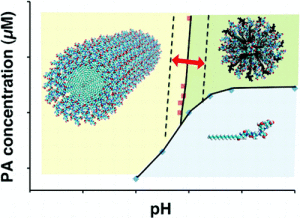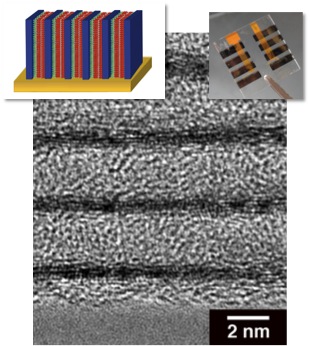Solid-State Materials at the Atomic Scale
Similar to how carbon can be sculpted into low-dimensional allotropes such as fullerenes, nanotubes, and graphene, the major premise of our research program is that the framework connectivity of atoms for any crystalline solid can be constrained along specific axes to produce stable, single atom or polyhedron thick (<1 nm) dimensionally-reduced derivatives with transformative physical phenomena. Using a combination of synthesis, electronic, optical, and thermal measurements and theoretical simulations we aim to establish a predictive understanding on how the electronic and phonon structure of the parent materials can be altered in this reduced framework and tuned via a surface bound ligand. Bestowing these novel properties onto existing materials is truly only possible on the atomic-scale, and is expected to lead to novel competitive optoelectronics, thermoelectrics, and spintronics. Our research is focused along numerous thrusts.
Current Directions
1) 2D Materials Beyond Graphene – Since the discovery of single-layer graphene’s unique electronic properties, there has been great interest in the synthesis, properties, and application of single layers of graphene and other inorganic two-dimensional layered sheets. We are creating new single-/few-atom thick layered materials that have novel optical, electronic, and magnetic properties and phenomena. Major directions in our lab involve creating and understanding the properties of new 2D topological insulators, and 2D magnets. These systems show great potential for next generation electronic materials, spintronics, and thermoelectrics.
Example Publications;
W. L. B. Huey, J. E. Goldberger, “Covalent Functionalization of Two-Dimensional Group 14 Graphane Analogues“, Chem. Soc. Rev., 47, 2601-2623, 2018. DOI: 10.1039/C8CS00291F
D. Weber, A. Trout, D. W. McComb, and J. E. Goldberger, “Decomposition-Induced Room Temperature Magnetism of the Na-intercalated Layered Ferromagnet” Nano Letters. 19, 5031-5035. (2019)
M.Q. Arguilla, J. Katoch, K. Krymowski, N. Cultrara, J. Xu, X. Xi, A. Hanks, S. Jiang, R.D. Ross, R.J. Koch, S. Ulstrup, A. Bostwick, C. Jozwiak, E. Rotenberg, D. McComb, J. Shan, W. Windl, R. K. Kawakami and J.E. Goldberger, “NaSn2As2: An Exfoliatable Layered van der Waals Zintl Phase” ACS Nano, 10, 9500–9508 (2016) DOI: 10.1021/acsnano.6b04609
E. Bianco, S. Butler, S. Jiang, O. Restrepo, W. Windl, J. Goldberger, “Stability and Exfoliation of Germanane: A Germanium Graphane Analogue“ ACS Nano, 7, 4414-4421, (2013).
S. Jiang, S. Butler, E. Bianco, O. Restrepo, W. Windl, J.E. Goldberger “Improving the stability and optoelectronic properties of germanane via one-step covalent methyl-termination” Nature Communications 5, 3389 (2014).
2) “Goniopolar” Materials – The textbook understanding of the electronic properties materials is that a single material gives rise to a single kind of electronic behavior. A material can either be a metal, or a semiconductor which is doped with other elements to produce either p-type or n-type behavior. Then, in almost all modern electronic devices these p-type and n-type regions are connected together for functionality. In characterizing the in-plane and cross-plane electronic properties of NaSn2As2, we have discovered a new class of materials that simultaneously behave n-type along one crystallographic axis, and p-type along an orthogonal axis, and established the fundamental mechanism behind this phenomena. This opens up the opportunity to potentially fabricate new electronic devices (photovoltaics, thermoelectrics, transistors) in a single crystal simply by changing its shape and contacting different crystal facets. Through a combination of computational predictions, single-crystal growth, and measurements, we are continuing to expand the scope of goniopolar materials, developing general solid-state chemistry design principles for these materials, and exploring their applications in new technologies.
Example Publications.
B. He, Y. Wang, M.Q. Arguilla, N.D. Cultrara, M.R. Scudder, J.E. Goldberger, W. Windl, J. Heremans,” The Fermi surface geometrical origin of axis-dependent conduction polarity in layered materials Nature Materials. 18, 568–572 (2019).
Y. Wang, K. Koster, A. Ochs, M. R. Scudder, J. P. Heremans, W. Windl, J. E. Goldberger, “The Chemical Design Principles for Axis-dependent Conduction Polarity,” J. Am. Chem. Soc. 142, 2812−2822, (2020).
A.M. Ochs, P. Gorai, Y. Wang, M.R. Scudder, K. Koster, C. E. Moore, J. P. Heremans, W. Windl, E. Toberer, J.E. Goldberger, “Computationally Guided Discovery of Axis-Dependent Conduction Polarity in NaSnAs Crystals” Chemistry of Materials, 33, 3, 946–951 (2021).
M.R. Scudder, B. He, Y. Wang, A. Rai, D. G. Cahill, W. Windl, J. P. Heremans, J. E. Goldberger, accepted.
3. New Solid-State Heterogeneous Catalysts – There remains a need for new catalysts and electrocatalysts that utilize less energy (i.e. operation at lower temperatures, lower overpotentials), that replace noble metals with earth-abundant elements, and that enable fundamentally new pathways to transform specific reactants into products. Our lab is focused on discovering new heterogeneous catalysts in previously unexplored families of solid-state compounds. As a recent example, we have recently established that BaGa2, a transition metal-free layered intermetallic compounds that reacts with H2 under moderate conditions to form BaGa2H2, is an excellent alkyne hydrogenation catalyst.
K. Hodge, J. E. Goldberger, “Transition Metal-Free Alkyne Hydrogenation Catalysis with BaGa2, a Hydrogen Absorbing Layered Zintl Phase.” Journal of the American Chemical Society, 141, 51, 19969-19972 (2019).
Previous Directions

4) Dimensionally-Reduced Metal Chalcogenides – Metal chalcogenides are some of the most well-studied classes of materials in the condensed matter research community due to the wealth of interesting physical phenomena and applications. We are rationally designing dimensionally reduced variants of these crystalline materials in order to create novel optoelectronic and battery materials.
Example publications;
Y.H. Liu, S. H. Porter, J. Goldberger, “Dimensional Reduction of a Layered Metal Chalcogenide into a 1D Near-IR Direct Band Gap Semiconductor” J. Am. Chem. Soc., 134, 5044-7 (2012).
T. Li*, Y.H. Liu*, B. Chitara, J. E. Goldberger “Li Intercalation into 1D TiS2(en) Chains” (*=co-authors) J. Am. Chem. Soc. 136, 2986-2989 (2014).
T. Li, Z. J. Baum, J. E. Goldberger, “A Vanadium Chalcogenide Dicubane” European Journal of Inorganic Chemistry. 2016, 28-32. DOI: 10.1002/ejic.201501189
R. Morasse, T. Li, Z. Baum, J. E. Goldberger “The Rational Synthesis of Dimensionally Reduced TiS2 phases” Chem. Mater., 26 4776–4780 (2014).
T. Li, J. E. Goldberger, “Atomic Scale Derivatives of Solid-State Materials” Chemistry of Materials. 27, 3549–3559, (2015).

5) Dynamic Self-assembling 0D/1D Materials for Medical Imaging We are learning how to exploit the superior properties of inorganic and peptide nanomaterials to improve upon the state-of-the-art medical diagnostic and therapeutics. For example, one of our long-term goals is to develop clinically translatable agents for detecting cancer using self-assembling peptide materials that contain different metals for imaging (MRI, PET, etc.). We are developing dynamic materials that respond to the chemistry of the tumor microvasculature to enhance the sensitivity of traditional diagnostic and therapeutic agents.
Example Publications;
A. Ghosh, M. Haverick, K. Stump, X. Yang, M. Tweedle, and J. Goldberger, “Fine-tuning the pH trigger of self-assembly” J. Am. Chem. Soc., 134, 3647-50 (2012).
A. Ghosh, E. T. Dobson, C. Buettner, M. Nicholl, J.E. Goldberger, “Programming pH-Triggered Self-Assembly Transitions via Isomerization of Peptide Sequences.” Langmuir, 30, 15383–15387, (2014).
A. Ghosh, C. J. Buettner, A. A. Manos, A. J. Wallace, M. F. Tweedle, J. E. Goldberger “Probing Peptide Self-Assembly in Serum” Biomacromolecules. 15 4488-4494, (2014).
6) Solution-phase Routes towards Carbides – Carbide materials occupy a very unique niche in particularly for high-temperature and catalysis applications due to the fact that they are incredibly refractory, chemically robust and electronically conducting ceramic materials. However, the C4- anion is the most synthetically intractable elemental anion in all of chemistry, and no low-temperature route towards preparation of metal carbides currently exists. We are creating the first general solution-phase routes towards carbide materials by establishing appropriate organometallic precursors and pathways. This chemistry allows us to prepare existing and new carbide materials in sol-gel, nanoparticle, and crystal forms.
Example Publications.
Z. Baum, J. Zhang, R. Morasse, J.E. Goldberger, “Stepwise trimethylsilyl and trimethylgermyl substitutions at tetraborylmethane” J. Organometallic Chem. 873, 50-56 (2018)

